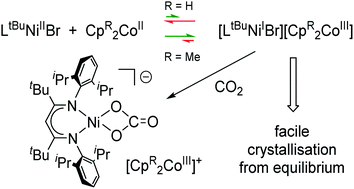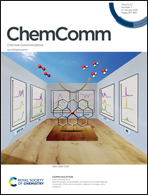Electron transfer within β-diketiminato nickel bromide and cobaltocene redox couples activating CO2†‡
Abstract
Reduction of β-diketiminato nickel(II) complexes (LtBuNiII) to the corresponding nickel(I) compounds does not require alkali metal compounds but can also be performed with the milder cobaltocenes. LtBuNiBr and Cp2Co have rather similar redox potentials, so that the equilibrium with the corresponding electron transfer compound [LtBuNiIBr][Cp2CoIII] (ETC) clearly lies on the side of the starting materials. Still, the ETC portion can be used to activate CO2 yielding a mononuclear nickel(II) carbonate complex and ETC can be isolated almost quantitatively from the solutions through crystallisation. The more negative reduction potential of Cp*2Co shifts the equilibrium formed with LtBuNiBr strongly towards the ETC and accordingly the reaction of such solutions with CO2 is much faster.

- This article is part of the themed collection: Bioinspired metal complexes for chemical transformations and catalysis


 Please wait while we load your content...
Please wait while we load your content...